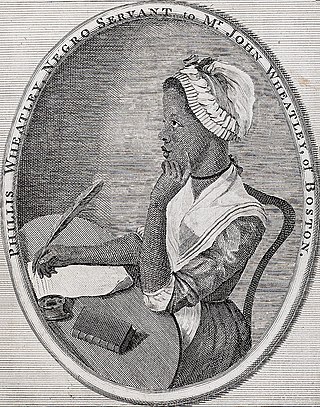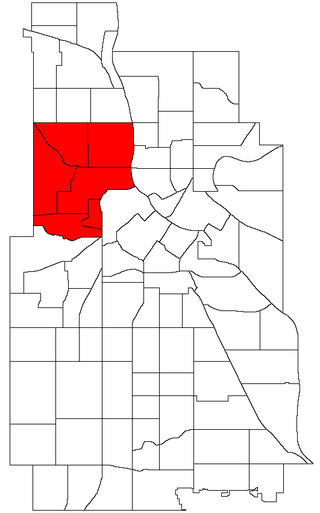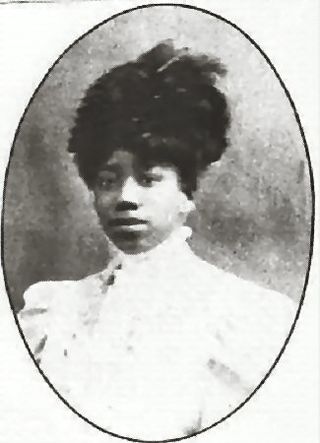
Phillis Wheatley Peters, also spelled Phyllis and Wheatly was an American author who is considered the first African-American author of a published book of poetry. Born in West Africa, she was kidnapped and subsequently sold into slavery at the age of seven or eight and transported to North America, where she was bought by the Wheatley family of Boston. After she learned to read and write, they encouraged her poetry when they saw her talent.

Wyandanch is a hamlet and census-designated place (CDP) in the Town of Babylon in Suffolk County, New York. The population was 12,990 at the 2020 census.

The Fifth Ward is a community of Houston, Texas, United States, derived from a historical political district (ward), about 2 miles (3.2 km) northeast of Downtown. Its boundaries are Buffalo Bayou on the south, Jensen Drive on the west, Collingsworth Rd on the north, and Lockwood Drive on the east.
Delano & Aldrich was an American Beaux-Arts architectural firm based in New York City. Many of its clients were among the wealthiest and most powerful families in the state. Founded in 1903, the firm operated as a partnership until 1935, when Aldrich left for an appointment in Rome. Delano continued in his practice nearly until his death in 1960.

Near North is a community in Minneapolis northwest of the city's downtown area that contains six smaller neighborhoods. The communities of Near North and Camden are often referred to colloquially as "North Minneapolis". In the early 1900s, the Near North area featured the population center of Jewish people in the city, and since the early 1900s it has been the location of a sizeable African American population and a cultural hub of Black residential and economic development.

William Harry Davis, Sr. was an American civil rights activist, amateur boxing coach, civic leader, and businessman in Minneapolis, Minnesota. He overcame poverty, childhood polio, and racial prejudice to become a humanitarian. Davis is remembered for his warm and positive personality, for coaching Golden Gloves champions in the upper Midwest, and for managing the Olympics boxing team that won nine gold medals. His contributions to public education in his community are enduring. A leader in desegregation during the Civil Rights Movement, Davis helped Americans find a way forward to racial equality.

Sumner Library is a neighborhood library located in the Near-north neighborhood of Minneapolis, Minnesota, United States. Originally part of the Minneapolis Public Library, it became part of the merged Hennepin County Library in 2008. The Carnegie Library was a haven for Jewish immigrants to the city in the early 20th century. The Minneapolis Public Library moved its entire collection of Yiddish and Hebrew works to the branch library in response to a survey showing that 95% of the patrons were Jewish immigrants, some of whom learned English there and participated in social clubs in the building. The Tudor Revival building is listed on the National Register of Historic Places.

Mabeth Hurd Paige was a Minnesota politician, a member of the Minnesota House of Representatives from 1923 to 1945.

Dr. Fannie Hagen Emanuel was an American medical doctor and civic leader active in Chicago over the early decades of the twentieth century. In 1908 she founded the Emanuel Settlement House in Chicago.

Greenwich House is a West Village settlement house in New York City.
Ada Sophia Dennison McKinley was an American educator, settlement house worker, and activist in Chicago, Illinois. She founded the South Side Settlement House, later renamed in her honor as Ada S. McKinley Community Services. The organization continues to serve thousands in the Chicago metropolitan area, Indiana, and Wisconsin. Because of her pioneering community service work, she is hailed as a "heroine of Chicago's South Side."
The Dallas–Fort Worth metroplex has 1.2 million African-Americans, the 2nd-largest metro population of African-Americans in Texas.

The Phillis Wheatley Clubs are women's clubs created by African Americans starting in the late 1800s. The first club was founded in Nashville, Tennessee, in 1895. Some clubs are still active. The purpose of Phillis Wheatley Clubs varied from area to area, although most were involved in community and personal improvement. Some clubs helped in desegregation and voting rights efforts. The clubs were named after the poet Phillis Wheatley.

Maude E. Craig Sampson Williams was an American suffragist, teacher, civil rights leader, and community activist in El Paso, Texas. In June 1918, she formed the El Paso Negro Woman's Civic and Equal Franchise League and requested membership in the National American Woman Suffrage Association (NAWSA) through the Texas Equal Suffrage Association (TESA), but was denied. Williams organized African-American women to register and vote in the Texas Democratic Party primary in July 1918. She was one of the founders and a charter member of the El Paso chapter of the NAACP, which was the first chapter in the state of Texas. Williams served as the vice president of the El Paso chapter from 1917 to 1924 and remained active in the NAACP until her death. Williams played a significant role in the desegregation of Texas Western College in 1955, which was the first undergraduate college in Texas to be desegregated by a court order other than that of the Supreme Court of the United States. Midwestern University (now known as Midwestern State University was previously ordered to desegregate in 1954 by the SCOTUS immediately following the Brown v. Board of Education ruling.

Mary Jane Richardson Jones was an American abolitionist, philanthropist, and suffragist. Born in Tennessee to free African-American parents, Jones and her family moved to Illinois. With her husband, John, she was a leading African-American figure in the early history of Chicago. The Jones household was a stop on the Underground Railroad and a center of abolitionist activity in the pre-Civil War era, helping hundreds of fugitive slaves flee slavery.

Mill Creek Valley was a historic neighborhood located in the central corridor between 20th Street and Saint Louis University in St. Louis, Missouri. European settlement began in the 18th century with mills established along La Petite Rivière, now known as Mill Creek. It became an industrial and railroad center in the 19th century. Union Station was opened in 1894. The building was closed in 1978 and renovated for commercial use. Also a residential and commercial center, Mill Creek Valley was populated by German immigrants and African Americans, before and after the Civil War. More people moved into the area during World War II to support the war effort.
Hallie Q. Brown Community Center is an African-American not-for-profit social service agency located in the Rondo neighborhood of Saint Paul, Minnesota, US, founded in 1929. Its slogan is 'Lighthouse of the Community'. The Hallie Q. Brown Community Center (HQB) is one of the largest African American non-profit organizations in the state of Minnesota. The center is named for Hallie Quinn Brown (1849–1950) a famous Black educator, activist, orator and writer agitating for civil rights, and women's rights. She also called out the injustices of the convict lease system. The organization supports the community with a full range of services including early childhood education, before and after school care, basic needs, senior programming, historical archives, and anti-racism and equity programming. HQB administers the Martin Luther King Service Center which consists of a little over half of the building and houses other agencies and organizations providing programming in the arts, recreation and other social and civic issues, including the nationally recognized Penumbra Theater Company. The City of Saint Paul administers the Martin Luther King Recreation Center, which consists of the remaining part of the overall building.

Frances Mary McHie Rains (1911–2006) was an American nurse. She was the first Black woman admitted to the University of Minnesota School of Nursing. She was admitted to the School of Nursing after the Minnesota State Legislature learned of her initial rejection from the school based on race. She graduated in 1932.

W. Gertrude Brown (1888–1939) was an American educator and social worker. She is best known as the first head resident of the Phyllis Wheatley Settlement House in Minneapolis, Minnesota.















